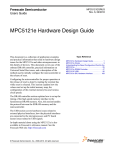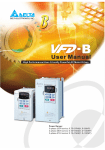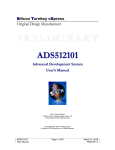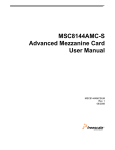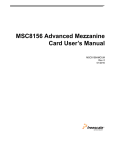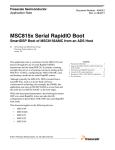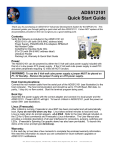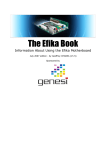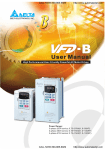Download NAND Flash Boot for the Freescale MPC5121e
Transcript
Freescale Semiconductor Application Note Document Number: AN3845 Rev. 0, 05/2009 NAND Flash Boot for the Freescale MPC5121e by: Gene Fortanely Applications Engineering Microcontroller Solutions Group 1 Introduction This document describes the procedures needed to perform NAND flash boot with a Freescale MPC5121e. The hardware platform used in this example is a Silicon Turnkey Express ADS512101 rev 4 board. Refer to the latest silicon and board documentation for updates to the information in this document. This document was written using the information in: 1. Freescale document MPC5121ERM, MPC5121e Microcontroller Reference Manual, Rev. 3, October 2008. 2. Silicon Turnkey Express document ADS512101UM, ADS512101 Advanced Development System User's Manual, Rev. 1.1, September 4, 2008. 3. Freescale document AN3765, “Porting Linux for the MPC5121e,” Rev. 0, 12/2008. © Freescale Semiconductor, Inc., 2009. All rights reserved. Contents 1 2 3 Introduction . . . . . . . . . . . . . . . . . . . . . . . . . . . . . . . . . . . 1 ADS512101 Board Preparation . . . . . . . . . . . . . . . . . . . . 2 MPC5121e Microcontroller Configuration . . . . . . . . . . . . 2 3.1 Reset . . . . . . . . . . . . . . . . . . . . . . . . . . . . . . . . . . . . 2 3.2 I/O Control . . . . . . . . . . . . . . . . . . . . . . . . . . . . . . . . 3 3.3 NAND Flash Boot . . . . . . . . . . . . . . . . . . . . . . . . . . 3 4 U-Boot NAND Flash Boot Software. . . . . . . . . . . . . . . . . 3 4.1 Adding NAND Flash Boot Support to U-boot. . . . . . 4 4.2 Files Modified in U-boot version u-boot-2008.10. . . 5 4.3 Description of the nand_spl Directory Source Code 6 5 NAND Flash Boot Software . . . . . . . . . . . . . . . . . . . . . . . 6 5.1 nandstart.S . . . . . . . . . . . . . . . . . . . . . . . . . . . . . . . 6 5.2 nandload.c . . . . . . . . . . . . . . . . . . . . . . . . . . . . . . . 11 Appendix A ADS512101 Top Board Layout . . . . . . . . . . . . . 15 ADS512101 Board Preparation 2 ADS512101 Board Preparation Verify your board is working. The board ships with a version of u-boot software in the NOR flash. U-boot should boot from NOR flash and give you a command prompt on the UART0 serial port. The UART0 serial port is configured to 115,200 baud, 8 data bits, 1 stop bit, and no hardware handshaking. The factory default for all eight of the SW3 positions is to be on. To make the board boot from NAND flash you must put SW3 position 2 to off. See the ADS512101 Advanced Development System User's Manual for further information including a board layout diagram that shows the location of SW3. The board layout diagram is included in this document as Appendix A, “ADS512101 Top Board Layout.” The ADS512101 uses a Hynix HY27UG088G(5/D)M 1 GB NAND flash which has a ×8 bus width, and is arranged into (2k + 64) pages. 3 MPC5121e Microcontroller Configuration 3.1 Reset Chapter 4, “Reset,” of the MPC5121e Microcontroller Reference Manual describes the reset process. Four fields in the Reset Configuration Word High Register (RCWHR) affect the NAND flash boot and they must be set accordingly. See section 4.7.2, “Reset Configuration Word High Register (RCWHR),” for further information regarding these four fields: • ROMLOC[1:0]—selects the boot device. A value of 01 or 11 will select a NAND boot. • NFC_PS—selects the NAND flash page size and is dependent on the value selected for ROMLOC[1:0]. • NFC_DBW—selects the NAND flash data port size. • BMS—selects where the e300 will fetch the first instruction, either at address 0x0000_0000 or at address 0xfff0_0000. Further information regarding these four RCWHR fields is also included in section 26.6.1, “Modes of Operation,” of the NFC chapter of the MPC5121e Microcontroller Reference Manual. Section 4.6.7, “NFC Initialization Sequence,” describes the steps that must be performed by the initial bootloader software when booting from NAND flash. This section also describes the functionality that can be deferred until the software is executing from DRAM. Here is a summary of the functionality that must be implemented in the NAND flash boot: 1. Configure the IMMR reset vector. 2. Configure the DRAM & NFC clock dividers. The default NFC clock values work fine, but increasing the clock speed will decrease boot time. 3. Configure the NFC parameters. 4. Initialize DRAM. Initialization should include DRAM access window as well as timings and initialization. 5. Copy the system software image to DRAM. The example code in this document uses a software loop to copy the image from NFC RAM to DRAM. However, DMA can also be used to copy the image, with the added benefit of decreased boot time. NAND Flash Boot for the Freescale MPC5121e, Rev. 0 2 Freescale Semiconductor U-Boot NAND Flash Boot Software 6. Perform absolute jump from NFC RAM to the DRAM system software image, where additional system initialization can be performed. A relative branch should not be used. 3.2 I/O Control Chapter 22, “IO Control,” of the MPC5121e Microcontroller Reference Manual describes the muxing and configuring of the pads. See the notes at the end of table 22-10, “Pad IO Control Register Table,” which point out that the default slew rates for the LPC and NFC signals depend on the designated boot source. The LPC/EMB pins, which are not used during NAND flash boot, are by default configured to the slowest slew rate. This behavior may need to be modified to meet the needs of your system. 3.3 NAND Flash Boot Chapter 26, “NAND Flash Controller (NFC),” of the MPC5121e Microcontroller Reference Manual describes the NAND flash boot process. Section 26.6.1, “Modes of Operation,” describes the Reset Configuration register (RCWHR) settings that must be set to reflect the hardware environment, specifically the NAND flash page size (NFC_PS), NAND flash bus width (NFC_DBW), and selecting the NAND flash as the boot ROM (ROMLOC[1:0]). Section 26.6.2, “Booting From a NAND Flash Device,” describes the boot process. This information describes the behavior of the MPC5121e silicon when the NAND flash is the boot ROM. The NFC ECC engine can correct four or eight symbols in an NFC page. If an unrecoverable number of symbol errors occur in the first NFC page, then software cannot do anything. If an unrecoverable number of symbol errors occur in any of the following NFC pages, then software can issue an error status, ignore the unrecoverable page, or read a duplicate copy of the page. Duplicate pages require that the NAND flash be programmed accordingly. 4 U-Boot NAND Flash Boot Software U-boot is a bootloader software available from www.denx.de. A u-boot that supports NAND flash boot for the MPC5121e was developed in early 2009 using u-boot version “u-boot-2008.10.” Four source code files are available with this document and can be downloaded in a zip file that should appear with this application note on freescale.com. The first two files are patch files used to create a complete u-boot source code tree with NAND flash boot support. The other two files are a subset of the u-boot source code tree, but provide easy access to these two key files. The files are: • u-boot_2008.10_ADS5121_NFC_NAND_Flash_Driver_20090130.patch • u-boot_2008.10_ADS5121_NAND_Flash_Boot_20090130.patch • nandstart.S • nandload.c Obtain u-boot version “u-boot-2008.10,” as this is the basis of the software for this document. This version of software will only provide support for a NOR flash u-boot image for the ADS512101 board. Verify you are able to successfully build and run a NOR flash u-boot image on your board. If you are unfamiliar with NAND Flash Boot for the Freescale MPC5121e, Rev. 0 Freescale Semiconductor 3 U-Boot NAND Flash Boot Software u-boot, refer to Freescale application note AN3765, “Porting Linux for the MPC5121e,” section 2.1, “u-boot Source Code from DENX,” for further instructions on how to obtain, configure, and build u-boot. 4.1 Adding NAND Flash Boot Support to U-boot To add NAND flash boot support to the u-boot version “u-boot-2008.10” source code tree, you must apply two patches. Copy the two patch files available with this document: • u-boot_2008.10_ADS5121_NFC_NAND_Flash_Driver_20090130.patch • u-boot_2008.10_ADS5121_NAND_Flash_Boot_20090130.patch to the base directory of your “u-boot-2008.10” source code tree. Then apply the two patch files in this order: 1. NAND flash driver patch 2. NAND flash boot patch Apply the patches like this: # patch file containing ADS5121 NAND flash driver support patch -p1 < u-boot_2008.10_ADS5121_NFC_NAND_Flash_Driver_20090130.patch #patch file containing ADS5121 NAND flash boot support patch -p1 < u-boot_2008.10_ADS5121_NAND_Flash_Boot_20090130.patch Once you have applied the patches, build a NAND flash boot u-boot image by entering the commands: #remove derived files make clean #config u-boot to build an ADS5121 NAND flash boot u-boot image make ADS5121_nand_config #make an ADS5121 NAND flash boot u-boot image make Once the “make” command has successfully completed executing, the u-boot images will exist. They are located in the base directory of your “u-boot-2008.10” source code tree and in the “nand_spl” sub-directory: nand_spl/u-boot-spl-2k.bin—the 2 KB image that is loaded as the first page from the NAND flash into the NFC internal RAM buffer. This image should be programmed into offset 0x0000_0000 of the NAND flash. u-boot.bin—the remaining portion of u-boot which is copied into DRAM by nand_spl/u-boot-spl-2k.bin. This image should be programmed into offset 0x0000_0800 of the NAND flash. u-boot-nand.bin—a concatenation of the two files listed above, nand_spl/u-boot-spl-2k.bin and u-boot.bin. If you wish to flash program the entire u-boot software in one operation, then this image should be programmed into offset 0x0000_0000 of the NAND flash. NAND Flash Boot for the Freescale MPC5121e, Rev. 0 4 Freescale Semiconductor U-Boot NAND Flash Boot Software To make your board boot from NAND flash, you need to program the u-boot-nand.bin image using a JTAG NAND flash programmer or a u-boot that has NAND flash programming capability. You must also configure your board to boot from NAND flash as described in Section 2, “ADS512101 Board Preparation.” To program u-boot-nand.bin using a u-boot that has NAND flash programming capability, the network settings must be configured appropriately. Refer to Freescale application note AN3765, “Porting Linux for the MPC5121e,” section 2.2, “u-boot Source Code from Freescale,” for further instructions on configuring the network settings. At the u-boot prompt enter these commands: # use the u-boot NAND flash driver to erase part of the NAND Flash nand erase 0 44000 # use tftp to do a network transfer of the u-boot-nand.bin image from the host server to the board tftp 300000 u-boot-nand.bin # use the u-boot NAND Flash driver to program the u-boot-nand.bin image nand write 300000 0 To initialize the bad block table in a NAND flash, use this command before attempting to erase or program the NAND flash from u-boot: # initialize NAND Flash bad block table nand bad To program u-boot-nand.bin using a JTAG NAND flash programmer, set the NAND flash programmer to program the binary image at an offset of 0x0000_0000. The NAND flash programmer must support the NAND flash part and configuration, which is described in Section 2, “ADS512101 Board Preparation.” 4.2 Files Modified in U-boot version u-boot-2008.10 Files that are modified to support the NAND flash driver in u-boot are: 1. board/ads5121/ads5121.c 2. drivers/mtd/nand/Makefile 3. drivers/mtd/nand/fsl_nfc_nand.c 4. include/configs/ads5121.h Files that are modified to support NAND flash boot in u-boot are: 1. Makefile 2. board/ads5121/ads5121.c 3. board/ads5121/config.mk 4. cpu/mpc512x/start.S 5. include/configs/ads5121.h 6. include/mpc512x.h 7. nand_spl/board/ads5121/Makefile NAND Flash Boot for the Freescale MPC5121e, Rev. 0 Freescale Semiconductor 5 NAND Flash Boot Software 8. nand_spl/board/ads5121/config.mk 9. nand_spl/board/ads5121/dram.h 10. nand_spl/board/ads5121/nandload.c 11. nand_spl/board/ads5121/nandstart.S 12. nand_spl/board/ads5121/nfc.h 13. nand_spl/board/ads5121/u-boot.lds 4.3 Description of the nand_spl Directory Source Code The nand_spl (secondary program loader) directory contains the source to build the image that is automatically loaded into the first page of the NAND flash. This first page is automatically loaded into the MPC5121e NFC memory during reset. The u-boot-2008.10/nand_spl/board/ads5121 directory contains the two source code files used to build the nand_spl image. These two source files are also included below in Section 5, “NAND Flash Boot Software.” The files are: 1. nandstart.S—First code to execute. Performs early initialization, calls nandload() function, and jumps to the fully loaded u-boot image once it is in DRAM. 2. nandload.c—Contains code that reads the entire u-boot image (as NAND flash pages) and writes them to DRAM. 5 NAND Flash Boot Software The initial bootloader software to execute in support of NAND flash boot on the MPC5121e should focus on following the algorithm described in the MPC5121e Microcontroller Reference Manual section 4.6.7, “NFC Initialization Sequence.” This initial bootloader software must configure the hardware platform including the DRAM, so that the entire system software can be copied from NAND flash to DRAM. This initial bootloader software is limited in size to either 2 KB or 4 KB. An alternative initial bootloader software algorithm that can be used to bypass the limit of a single NAND flash page of 512 bytes or 2 KB involves loading intermediate initial software, or even the entire system software, into the MPC5121e 128 KB on-chip SRAM. The following code provides example code that performs the algorithm described in the MPC5121e Microcontroller Reference Manual section 4.6.7, “NFC Initialization Sequence.” This code is from the u-boot bootloader software. See Section 4, “U-Boot NAND Flash Boot Software,” for further information regarding u-boot. 5.1 nandstart.S u-boot-2008.10/nand_spl/board/ads5121/nandstart.S /* * (C) Copyright 2009 * Martha Marx, Silicon Turnkey Express, [email protected] * * Based on original start.S done by * Copyright (C) 1998 Dan Malek <[email protected]> * Copyright (C) 1999 Magnus Damm <kieraypc01.p.y.kie.era.ericsson.se> NAND Flash Boot for the Freescale MPC5121e, Rev. 0 6 Freescale Semiconductor NAND Flash Boot Software * Copyright (C) 2000, 2001, 2002, 2007 Wolfgang Denk <[email protected]> * start.S for mpc512x was originally based on the MPC83xx code. * * See file CREDITS for list of people who contributed to this * project. * * This program is free software; you can redistribute it and/or * modify it under the terms of the GNU General Public License as * published by the Free Software Foundation; either version 2 of * the License, or (at your option) any later version. * * This program is distributed in the hope that it will be useful, * but WITHOUT ANY WARRANTY; without even the implied warranty of * MERCHANTABILITY or FITNESS FOR A PARTICULAR PURPOSE. See the * GNU General Public License for more details. * * You should have received a copy of the GNU General Public License * along with this program; if not, write to the Free Software * Foundation, Inc., 59 Temple Place, Suite 330, Boston, * MA 02111-1307 USA */ /* * U-Boot - NAND Boot Startup Code for MPC5121 Embedded Boards */ #define DEBUG #include #include #include #include #include <config.h> <mpc512x.h> <version.h> "dram.h" "nfc.h" #define CONFIG_521X1/* needed for Linux kernel header files*/ #include <ppc_asm.tmpl> #include <ppc_defs.h> #include <asm/cache.h> #include <asm/mmu.h> #ifndef #define #endif CONFIG_IDENT_STRING CONFIG_IDENT_STRING "MPC512X" /* * Floating Point enable, Machine Check and Recoverable Interr. */ #undef MSR_KERNEL #ifdef DEBUG #define MSR_KERNEL (MSR_FP|MSR_RI) #else #define MSR_KERNEL (MSR_FP|MSR_ME|MSR_RI) #endif /* Macros for manipulating CSx_START/STOP */ #define START_REG(start)((start) >> 16) NAND Flash Boot for the Freescale MPC5121e, Rev. 0 Freescale Semiconductor 7 NAND Flash Boot Software #define STOP_REG(start, size)(((start) + (size) - 1) >> 16) #define SET_MEM_BASE(r, b) \ lis r,(b)@h;\ ori r,r,(b)@l;\ #define SET_REG32(r, v, offset, mr)\ lis r, v@h; \ ori r, r, v@l;\ stw r, offset(mr);\ #define SET_REG16(r, v, offset, mr)\ li r, v; \ sth r, offset(mr);\ .text .globl version_string version_string: .ascii U_BOOT_VERSION .ascii " (", __DATE__, " - ", __TIME__, ")" .ascii " ", CONFIG_IDENT_STRING, " " .ascii "2K NAND BOOT ","\0" . = EXC_OFF_SYS_RESET .globl _start /* Start from here after reset/power on */ _start: boot_cold: /* Save msr contents */ mfmsr r5 lis r4, CONFIG_DEFAULT_IMMR@h /* Set IMMR area to our preferred location */ mfspr r6, MBAR lis r3, CFG_IMMR@h ori r3, r3, CFG_IMMR@l cmpw r3, r6 beq 1f /* it has already been set to what we want it to be */ /* -- nice to chk if coming out of the BDI */ 1: stw r3, IMMRBAR(r4) mtspr MBAR, r3 /* IMMRBAR is mirrored into the MBAR SPR (311) */ isync lis r4, START_REG(CFG_FLASH_BASE) ori r4, r4, STOP_REG(CFG_FLASH_BASE, CFG_FLASH_SIZE) stw r4, LPBAW(r3) stw r4, LPCS0AW(r3) isync /* Initialise the machine */ bl cpu_early_init isync /* * The SRAM window has a fixed size (256K), * so only the start addressis necessary */ NAND Flash Boot for the Freescale MPC5121e, Rev. 0 8 Freescale Semiconductor NAND Flash Boot Software lis ori lis stw r3, CFG_IMMR@h r3, r3, CFG_IMMR@l r4, START_REG(CFG_SRAM_BASE) & 0xff00 r4, SRAMBAR(r3) /* * According to MPC5121e RM, configuring local access windows should * be followed by a dummy read of the config register that was * modified last and an isync */ lwz r4, SRAMBAR(r3) isync /* r3: BOOTFLAG */ mr r3, r21 bl dram_init /* r3: BOOTFLAG */ mr r3, r21 lis r1, (CFG_INIT_RAM_ADDR + CFG_GBL_DATA_OFFSET)@h ori r1, r1, (CFG_INIT_RAM_ADDR + CFG_GBL_DATA_OFFSET)@l /* copy the full U-Boot into DDR */ bl nandload /* and jump to it */ jump_uboot: SET_MEM_BASE(r10, CFG_NAND_U_BOOT_START) mtlr r10 isync blr /* NOTREACHED - nand_boot() does not return */ /* * This code initialises the machine, * it expects original MSR contents to be in r5 */ cpu_early_init: /* Initialize machine status; enable machine check interrupt */ /*-----------------------------------------------------------*/ li rlwimi #ifdef DEBUG rlwimi #endif mtmsr SYNC mtspr lis r3, MSR_KERNEL /* Set ME and RI flags */ r3, r5, 0, 25, 25/* preserve IP bit */ r3, r5, 0, 21, 22/* debugger might set SE, BE bits */ r3 SRR1, r3 /* Mirror current MSR state in SRR1 */ r3, CFG_IMMR@h /* Disable the watchdog */ /*----------------------*/ lwz r4, SWCRR(r3) /* * Check to see if it’s enabled for disabling: once disabled by s/w NAND Flash Boot for the Freescale MPC5121e, Rev. 0 Freescale Semiconductor 9 NAND Flash Boot Software * it’s not possible to re-enable it */ andi. r4, r4, 0x4 beq 1f xor r4, r4, r4 stw r4, SWCRR(r3) 1: /* Initialize the Hardware Implementation-dependent Registers */ /* HID0 also contains cache control*/ /*------------------------------------------------------*/ lis r3, CFG_HID0_INIT@h ori r3, r3, CFG_HID0_INIT@l SYNC mtspr HID0, r3 blr dram_init: SET_MEM_BASE(r3, CFG_IMMR + IOCTL_BASE_ADDR) SET_REG32(r4, IOCTRL_MUX_DDR, IOCTL_MEM , r3) SET_MEM_BASE(r3, CFG_IMMR) SET_REG32(r4, CFG_DDR_BASE & 0xFFFFF000, DDR_LAW_BAR, r3) SET_REG32(r4, 0x0000001c, DDR_LAW_AR, r3) lwz r0, DDR_LAW_AR(r3) isync SET_MEM_BASE(r3, CFG_IMMR + MDDRC_BASE_OFFSET) SET_REG32(r4, CFG_MDDRC_SYS_CFG_EN, DDR_SYS_CONFIG, r3) SET_REG32(r4, SET_REG32(r4, SET_REG32(r4, SET_REG32(r4, SET_REG32(r4, SET_REG32(r4, SET_REG32(r4, SET_REG32(r4, SET_REG32(r4, SET_REG32(r4, SET_REG32(r4, SET_REG32(r4, SET_REG32(r4, SET_REG32(r4, SET_REG32(r4, SET_REG32(r4, SET_REG32(r4, SET_REG32(r4, SET_REG32(r4, SET_REG32(r4, SET_REG32(r4, SET_REG32(r4, SET_REG32(r4, CFG_MDDRCGRP_PM_CFG1, DRAMPRIOM_PRIOMAN_CONFIG1, r3) CFG_MDDRCGRP_PM_CFG2, DRAMPRIOM_PRIOMAN_CONFIG2, r3) CFG_MDDRCGRP_HIPRIO_CFG, DRAMPRIOM_HIPRIO_CONFIG, r3) CFG_MDDRCGRP_LUT0_MU, DRAMPRIOM_LUT_TABLE0_MAIN_UP, r3) CFG_MDDRCGRP_LUT0_ML, DRAMPRIOM_LUT_TABLE0_MAIN_LOW, r3) CFG_MDDRCGRP_LUT1_MU, DRAMPRIOM_LUT_TABLE1_MAIN_UP, r3) CFG_MDDRCGRP_LUT1_ML, DRAMPRIOM_LUT_TABLE1_MAIN_LOW, r3) CFG_MDDRCGRP_LUT2_MU, DRAMPRIOM_LUT_TABLE2_MAIN_UP, r3) CFG_MDDRCGRP_LUT2_ML, DRAMPRIOM_LUT_TABLE2_MAIN_LOW, r3) CFG_MDDRCGRP_LUT3_MU, DRAMPRIOM_LUT_TABLE3_MAIN_UP, r3) CFG_MDDRCGRP_LUT3_ML, DRAMPRIOM_LUT_TABLE3_MAIN_LOW, r3) CFG_MDDRCGRP_LUT4_MU, DRAMPRIOM_LUT_TABLE4_MAIN_UP, r3) CFG_MDDRCGRP_LUT4_ML, DRAMPRIOM_LUT_TABLE4_MAIN_LOW, r3) CFG_MDDRCGRP_LUT0_AU, DRAMPRIOM_LUT_TABLE0_ALT_UP, r3) CFG_MDDRCGRP_LUT0_AL, DRAMPRIOM_LUT_TABLE0_ALT_LOW, r3) CFG_MDDRCGRP_LUT1_AU, DRAMPRIOM_LUT_TABLE1_ALT_UP, r3) CFG_MDDRCGRP_LUT1_AL, DRAMPRIOM_LUT_TABLE1_ALT_LOW, r3) CFG_MDDRCGRP_LUT2_AU, DRAMPRIOM_LUT_TABLE2_ALT_UP, r3) CFG_MDDRCGRP_LUT2_AL, DRAMPRIOM_LUT_TABLE2_ALT_LOW, r3) CFG_MDDRCGRP_LUT3_AU, DRAMPRIOM_LUT_TABLE3_ALT_UP, r3) CFG_MDDRCGRP_LUT3_AL, DRAMPRIOM_LUT_TABLE3_ALT_LOW, r3) CFG_MDDRCGRP_LUT4_AU, DRAMPRIOM_LUT_TABLE4_ALT_UP, r3) CFG_MDDRCGRP_LUT4_AL, DRAMPRIOM_LUT_TABLE4_ALT_LOW, r3) /* Initialize MDDRC */ NAND Flash Boot for the Freescale MPC5121e, Rev. 0 10 Freescale Semiconductor NAND Flash Boot Software SET_REG32(r4, SET_REG32(r4, SET_REG32(r4, SET_REG32(r4, CFG_MDDRC_SYS_CFG_EN, DDR_SYS_CONFIG, r3) CFG_MDDRC_TIME_CFG0, DDR_TIME_CONFIG0, r3) CFG_MDDRC_TIME_CFG1, DDR_TIME_CONFIG1, r3) CFG_MDDRC_TIME_CFG2, DDR_TIME_CONFIG2, r3) /* Initialize DDR */ SET_REG32(r4, CFG_MICRON_NOP, DDR_COMMAND, r3) stw r4, DDR_COMMAND(r3); stw r4, DDR_COMMAND(r3); stw r4, DDR_COMMAND(r3); stw r4, DDR_COMMAND(r3); stw r4, DDR_COMMAND(r3); stw r4, DDR_COMMAND(r3); stw r4, DDR_COMMAND(r3); stw r4, DDR_COMMAND(r3); stw r4, DDR_COMMAND(r3); stw r4, DDR_COMMAND(r3); SET_REG32(r4, CFG_MICRON_PCHG_ALL, DDR_COMMAND, r3) SET_REG32(r5, CFG_MICRON_NOP, DDR_COMMAND, r3) SET_REG32(r4, CFG_MICRON_RFSH, DDR_COMMAND, r3) stw r5, DDR_COMMAND(r3); SET_REG32(r4, CFG_MICRON_RFSH, DDR_COMMAND, r3) stw r5, DDR_COMMAND(r3); SET_REG32(r4, CFG_MICRON_INIT_DEV_OP, DDR_COMMAND, r3) stw r5, DDR_COMMAND(r3); SET_REG32(r4, CFG_MICRON_EM2, DDR_COMMAND, r3) stw r5, DDR_COMMAND(r3); SET_REG32(r4, CFG_MICRON_PCHG_ALL, DDR_COMMAND, r3) SET_REG32(r4, CFG_MICRON_EM2, DDR_COMMAND, r3) SET_REG32(r4, CFG_MICRON_EM3, DDR_COMMAND, r3) SET_REG32(r4, CFG_MICRON_EN_DLL, DDR_COMMAND, r3) SET_REG32(r4, CFG_MICRON_INIT_DEV_OP, DDR_COMMAND, r3) SET_REG32(r4, CFG_MICRON_PCHG_ALL, DDR_COMMAND, r3) SET_REG32(r4, CFG_MICRON_RFSH, DDR_COMMAND, r3) SET_REG32(r4, CFG_MICRON_INIT_DEV_OP, DDR_COMMAND, r3) SET_REG32(r4, CFG_MICRON_OCD_DEFAULT, DDR_COMMAND, r3) SET_REG32(r4, CFG_MICRON_PCHG_ALL, DDR_COMMAND, r3) stw r5, DDR_COMMAND(r3); /* Start MDDRC */ SET_REG32(r4, CFG_MDDRC_TIME_CFG0_RUN, DDR_TIME_CONFIG0, r3) SET_REG32(r4, CFG_MDDRC_SYS_CFG_RUN, DDR_SYS_CONFIG, r3) isync blr 5.2 nandload.c u-boot-2008.10/nand_spl/board/ads5121/nandload.c /* * (C) Copyright 2009 NAND Flash Boot for the Freescale MPC5121e, Rev. 0 Freescale Semiconductor 11 NAND Flash Boot Software * Martha Marx, Silicon Turnkey Express, [email protected] * * See file CREDITS for list of people who contributed to this * project. * * This program is free software; you can redistribute it and/or * modify it under the terms of the GNU General Public License as * published by the Free Software Foundation; either version 2 of * the License, or (at your option) any later version. * * This program is distributed in the hope that it will be useful, * but WITHOUT ANY WARRANTY; without even the implied warranty of * MERCHANTABILITY or FITNESS FOR A PARTICULAR PURPOSE. See the * GNU General Public License for more details. * * You should have received a copy of the GNU General Public License * along with this program; if not, write to the Free Software * Foundation, Inc., 59 Temple Place, Suite 330, Boston, * MA 02111-1307 USA */ #include <common.h> #include <mpc512x.h> #include <version.h> #define CONFIG_521X1/* needed for Linux kernel header files*/ #include #include #include #include #include #include #include <ppc_asm.tmpl> <ppc_defs.h> <asm/bitops.h> <asm/io.h> <asm/cache.h> <asm/mmu.h> "nfc.h" /*! * This function polls the NFC to wait for the basic operation to complete by * checking the INT bit of config2 register. * * @max_retries number of retry attempts */ static void wait_op_mjmdone(void) { int i; int max_retries = 10000; u16 output; u16 temp; while (1) { max_retries--; output = in_be16((u16 *)(CFG_NAND_BASE + NFC_NF_CFG2)); temp = output; if (output & NFC_INT) { out_be16((u16 *)(CFG_NAND_BASE + NFC_NF_CFG2), 0x0); break; } else for (i = 1000; i > 0; i--) { NAND Flash Boot for the Freescale MPC5121e, Rev. 0 12 Freescale Semiconductor NAND Flash Boot Software if (temp >= 0x8ffa) break; } if (max_retries <= 0) max_retries += 10000; } return; } void nandload(void) { /* nand init */ out_be16((u16 *)(CFG_NAND_BASE + NFC_NFC_CFG), 0x0002); out_be16((u16 *)(CFG_NAND_BASE + NFC_SPAS), 0x0020); out_be16((u16 *)(CFG_NAND_BASE + NFC_NF_CFG1), 0x0cb2); out_be16((u16 *)(CFG_NAND_BASE + NFC_FLASH_CMD), NAND_CMD_READ0); out_be16((u16 *)(CFG_NAND_BASE + NFC_NF_CFG2), NFC_CMD); wait_op_mjmdone(); out_be16((u16 *)(CFG_NAND_BASE + NFC_FLASH_ADDR), 0x0); out_be16((u16 *)(CFG_NAND_BASE + NFC_NF_CFG2), NFC_ADDR); wait_op_mjmdone(); out_be16((u16 *)(CFG_NAND_BASE + NFC_NF_CFG2), NFC_ADDR); wait_op_mjmdone(); out_be16((u16 *)(CFG_NAND_BASE + NFC_NF_CFG2), NFC_ADDR); wait_op_mjmdone(); out_be16((u16 *)(CFG_NAND_BASE + NFC_NF_CFG2), NFC_ADDR); wait_op_mjmdone(); out_be16((u16 *)(CFG_NAND_BASE + NFC_NF_CFG2), NFC_ADDR); wait_op_mjmdone(); out_be16((u16 *)(CFG_NAND_BASE + NFC_FLASH_CMD), NAND_CMD_READCACHE); out_be16((u16 *)(CFG_NAND_BASE + NFC_NF_CFG2), NFC_CMD); wait_op_mjmdone(); unsigned long *i, *j; int k; int num_pages = NUMPAGES; unsigned long *mem_idx = (unsigned long *)0x100; i = (unsigned long *)CFG_NAND_U_BOOT_DST; do { /* readout a page and copy to mem -cache mode means we can skip the address cycle */ out_be16((u16 *)(CFG_NAND_BASE + NFC_RAM_BUF_ADDR), RAM_BUFFER_ADDRESS_RBA_4); out_be16((u16 *)(CFG_NAND_BASE + NFC_NF_CFG2), NFC_OUTPUT); /* Wait for operation to complete */ wait_op_mjmdone(); for (j = (u32 *)(CFG_NAND_BASE + TWO_K), k = 0; k < TWO_K/4; i++, j++, k++) { *i = *j; /* put exception vectors at 0x0 - vector size is 0x13ff */ if (i >= (u32 *)(CFG_NAND_U_BOOT_DST + TWO_K + 0x100) && mem_idx < (u32 *)0x1400) (*(mem_idx++)) = *j; } NAND Flash Boot for the Freescale MPC5121e, Rev. 0 Freescale Semiconductor 13 NAND Flash Boot Software num_pages--; } while (num_pages > 0); out_be16((u16 *)(CFG_NAND_BASE + NFC_FLASH_CMD), NAND_CMD_READCACHEND); out_be16((u16 *)(CFG_NAND_BASE + NFC_NF_CFG2), NFC_CMD); wait_op_mjmdone(); return; } NAND Flash Boot for the Freescale MPC5121e, Rev. 0 14 Freescale Semiconductor ADS512101 Top Board Layout Appendix A ADS512101 Top Board Layout NAND Flash Boot for the Freescale MPC5121e, Rev. 0 Freescale Semiconductor 15 How to Reach Us: Home Page: www.freescale.com Web Support: http://www.freescale.com/support USA/Europe or Locations Not Listed: Freescale Semiconductor, Inc. Technical Information Center, EL516 2100 East Elliot Road Tempe, Arizona 85284 +1-800-521-6274 or +1-480-768-2130 www.freescale.com/support Europe, Middle East, and Africa: Freescale Halbleiter Deutschland GmbH Technical Information Center Schatzbogen 7 81829 Muenchen, Germany +44 1296 380 456 (English) +46 8 52200080 (English) +49 89 92103 559 (German) +33 1 69 35 48 48 (French) www.freescale.com/support Japan: Freescale Semiconductor Japan Ltd. Headquarters ARCO Tower 15F 1-8-1, Shimo-Meguro, Meguro-ku, Tokyo 153-0064 Japan 0120 191014 or +81 3 5437 9125 [email protected] Asia/Pacific: Freescale Semiconductor China Ltd. Exchange Building 23F No. 118 Jianguo Road Chaoyang District Beijing 100022 China +86 10 5879 8000 [email protected] For Literature Requests Only: Freescale Semiconductor Literature Distribution Center 1-800-441-2447 or +1-303-675-2140 Fax: +1-303-675-2150 [email protected] Document Number: AN3845 Rev. 0 05/2009 Information in this document is provided solely to enable system and software implementers to use Freescale Semiconductor products. There are no express or implied copyright licenses granted hereunder to design or fabricate any integrated circuits or integrated circuits based on the information in this document. Freescale Semiconductor reserves the right to make changes without further notice to any products herein. Freescale Semiconductor makes no warranty, representation or guarantee regarding the suitability of its products for any particular purpose, nor does Freescale Semiconductor assume any liability arising out of the application or use of any product or circuit, and specifically disclaims any and all liability, including without limitation consequential or incidental damages. “Typical” parameters that may be provided in Freescale Semiconductor data sheets and/or specifications can and do vary in different applications and actual performance may vary over time. All operating parameters, including “Typicals”, must be validated for each customer application by customer’s technical experts. Freescale Semiconductor does not convey any license under its patent rights nor the rights of others. Freescale Semiconductor products are not designed, intended, or authorized for use as components in systems intended for surgical implant into the body, or other applications intended to support or sustain life, or for any other application in which the failure of the Freescale Semiconductor product could create a situation where personal injury or death may occur. Should Buyer purchase or use Freescale Semiconductor products for any such unintended or unauthorized application, Buyer shall indemnify and hold Freescale Semiconductor and its officers, employees, subsidiaries, affiliates, and distributors harmless against all claims, costs, damages, and expenses, and reasonable attorney fees arising out of, directly or indirectly, any claim of personal injury or death associated with such unintended or unauthorized use, even if such claim alleges that Freescale Semiconductor was negligent regarding the design or manufacture of the part. RoHS-compliant and/or Pb-free versions of Freescale products have the functionality and electrical characteristics as their non-RoHS-compliant and/or non-Pb-free counterparts. For further information, see http://www.freescale.com or contact your Freescale sales representative. For information on Freescale’s Environmental Products program, go to http://www.freescale.com/epp. Freescale™ and the Freescale logo are trademarks of Freescale Semiconductor, Inc. All other product or service names are the property of their respective owners. The Power Architecture and Power.org word marks and the Power and Power.org logos and related marks are trademarks and service marks licensed by Power.org © Freescale Semiconductor, Inc. 2009. All rights reserved.
















